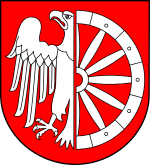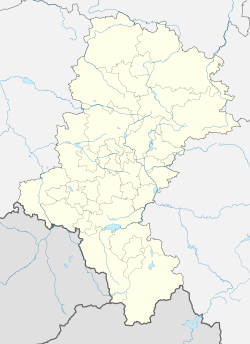Racibórz
Racibórz [raˈt͡ɕibuʂ] (German: Ratibor, Czech: Ratiboř, Silesian: Racibōrz) is a town in Silesian Voivodeship in southern Poland. It is the administrative seat of Racibórz County.
- For the community in Saxony, Germany, see Radibor. For the village in northern Poland, see Racibórz, Warmian-Masurian Voivodeship.
Racibórz | |
|---|---|
Former Holy Spirit Church, now a museum, 14th century | |
 Flag  Coat of arms | |
 Racibórz  Racibórz | |
| Coordinates: 50°5′N 18°14′E | |
| Country | |
| Voivodeship | |
| County | Racibórz |
| Gmina | Racibórz (urban gmina) |
| Established | 12th century |
| City rights | 1217 |
| Government | |
| • Mayor | Mirosław Lenk (PO) |
| Area | |
| • City | 74.96 km2 (28.94 sq mi) |
| Population (2019-06-30[1]) | |
| • City | 54,778 |
| • Density | 730/km2 (1,900/sq mi) |
| • Metro | 115,164 |
| Time zone | UTC+1 (CET) |
| • Summer (DST) | UTC+2 (CEST) |
| Postal code | 47-400 to 47-445 |
| Area code(s) | +48 32 |
| Car plates | SRC |
| Website | www.raciborz.pl |
Duchy of Ratibor | |||||||||
|---|---|---|---|---|---|---|---|---|---|
| 1336–1815 | |||||||||
| Status | Vassal of Bohemia | ||||||||
| Capital | Ratibor (Racibórz) | ||||||||
| Government | Principality | ||||||||
| Historical era | Middle Ages | ||||||||
| 1336 1336 | |||||||||
| June 9, 1815 1815 | |||||||||
| |||||||||
With Opole, Racibórz is one of the historic capitals of Upper Silesia, being the residence of the Dukes of Racibórz from 1172 to 1521.
Geography
The town is situated in the southwest of the voivodeship on the upper Oder river, near the border with the Polish Opole Voivodeship and the Czech Republic. The Racibórz Basin (Kotlina Raciborska) forms the southeastern extension of the Silesian Lowlands, surrounded by the Opawskie Mountains in the west (part of the Eastern Sudetes), the Silesian Upland in the north, and the Moravian Gate in the south. The town centre is located about 75 kilometres (47 mi) southwest of Katowice and about 160 kilometres (99 mi) southeast of the regional capital Wrocław.
As of 2019, the town has a population of approximately 55,000 inhabitants. From 1975 to 1998, it belonged to Katowice Voivodeship.
History
Until the end of the 5th century AD, the lands of the later Racibórz settlement were inhabited by East Germanic Silinger tribes. The town is one of the oldest in Upper Silesia, the site of a hill fort where the old trade route from the Moravian Gate down to Kraków crossed the Oder river. There is a possibility that Racibórz was mentioned in a work of the "Bavarian Geographer" in 845 (this document mentions five strongholds of the Slavic Golensizi (Golenshitse, Holasici in Czech), a proto-Polish tribe, probably Racibórz was one of them).[2] The name Racibórz is of Slavic origin and probably is derived from the name of one Duke Racibor, the city's founder.
Middle Ages
However, the first confirmed mention of Racibórz was made in 1108 in the Gesta principum Polonorum chronicle by the Benedictine monk Gallus Anonymus,[3] at a time when the Polish duke Bolesław III Wrymouth had to ward off the attacks by the forces of Duke Svatopluk of Bohemia invading from the Moravian lands in the south. The Polish rule over the Racibórz area was confirmed in 1137, it was incorporated into the Duchy of Silesia according to the Testament of Bolesław III Krzywousty in the following year.
From 1155, Racibórz was the seat of a castellany. The town became the first historical capital of Upper Silesia, when the Duchy of Racibórz was established by the Piast duke Mieszko I Tanglefoot upon the first partition of Silesia in 1172. From 1202 onwards, Duke Mieszko ruled over whole Upper Silesia as Duke of Opole and Racibórz. He had the settlement beneath his residence laid out and the area colonized by Flemish merchants, the first coin with the Polish description "MILOST" was issued in Racibórz in 1211. Mieszko's son and successor Duke Casimir I granted the Racibórz citizens municipal privileges in 1217.
Under the rule of Mieszko II the Fat, the town resisted the Mongol invasion of 1241 and the Duke founded a Dominican monastery in the city, where he was buried in 1246. The first Polish national anthem Gaude Mater Polonia was written ca. 1260–70 in Latin by the Dominican brother Wincenty of Kielcza. In 1285 Duke Przemysław of Racibórz granted the Wrocław bishop Thomas II Zaremba asylum during his fierce struggle with the Silesian duke Henry IV Probus. In turn, Bishop Thomas donated a college of canons at Racibórz Castle, dedicated to Saint Thomas of Canterbury. Duke Przemysław also founded a Dominican nunnery and his daughter Euphemia became its first prioress in 1313. Around 1300, the Dominican friar Peregrine of Opole compiled his Sermones de tempore and Sermones de sanctis collections.
From 1299 onwards, Racibórz was ruled by an autonomous city council according to Magdeburg town law. When in 1327 Duke Leszek of Racibórz paid homage to the Luxembourg king John of Bohemia, his duchy became a Bohemian fiefdom. The Bohemian feudal suzerainty, confirmed in the 1335 Treaty of Trentschin, led to the seizure of Racibórz as a reverted fief, when the line of the Silesian Piasts became extinct upon Duke Leszek's death in 1336. The next year King John enfeoffed Leszek's brother-in-law Duke Nicholas II of Opava with the duchy, which from that time on was ruled by the Opava cadet branch of the Bohemian Přemyslid dynasty and incorporated into the Lands of the Bohemian Crown. The Racibórz citizens retained their autonomy and the town developed to an important commercial centre for the region with significant cloth, tanning and brewing industries.
Modern Era
When the last Přemyslid duke Valentin died and was buried in the Dominican church in 1521, Racibórz according to a 1512 inheritance treaty fell to the Opole dukes Jan II the Good, also a vassal of Bohemian king. As he himself left no male heirs, his lands fell back to the Habsburg king Ferdinand I. With Opole, Racibórz was temporarily given in pawn to the Hohenzollern margraves of Ansbach and to the royal Polish House of Vasa. The town's economy suffered from the devastations in the Thirty Years' War.
After the First Silesian War in 1742, Racibórz was ceded to the Kingdom of Prussia under Frederick the Great. With most of the Silesian territory it was incorporated into the Province of Silesia in 1815 and the town became the administrative seat of a Landkreis. The mediate Lordship of Ratibor was acquired by Elector William I of Hesse in 1812, succeeded by Landgrave Victor Amadeus of Hesse-Rotenburg in 1821 and Prince Victor of Hohenlohe-Schillingsfürst in 1834, who was vested with the title of a "Duke of Ratibor" by King Frederick William IV of Prussia in 1840. At that time, Ratibor had already lost its status as a residential town, while the princes held court in the secularised monastery of Rausen. In the 19th century, Prussian policies increased the Germanisation. Ratibor became part of the German Empire in 1871. The famous German Romantic poet Joseph Freiherr von Eichendorff, a Roman Catholic Silesian nobleman, was born at Lubowitz castle near the town in 1788.
After World War I, Ratibor was incorporated in the Prussian Province of Upper Silesia, it became a border town after the Upper Silesia plebiscite in 1921. During World War II, it was initially spared by the Red Army Vistula–Oder Offensive but occupied and devastated on 30 March 1945. After end of the war, in June 1945, the army of Czechoslovakia briefly entered into the town and Czechoslovakia officially claimed the area of Racibórz and Głubczyce (Ratibořsko and Hlubčicko) because of having a substantial Czech minority (see border conflicts between Poland and Czechoslovakia). At the same time the expulsion of Germans started, while the town became wholly part of Poland as defined at the Potsdam Conference. The German CDU politician Herbert Hupka at the end of his life promoted reconciliation between the former German inhabitants, including himself, and the new Polish settlers and administration of Racibórz. In 1997, a flood devastated the town.
Districts
- Centrum
- Nowe Zagrody
- Ocice
- Stara Wieś
- Miedonia
- Ostróg
- Markowice
- Płonia
- Brzezie
- Sudół
- Studzienna
- Obora
Notable people
- Joseph Freiherr von Eichendorff (1788–1857), Prussian poet, playwright
- Ludwig Traube (1818–1876), German physician
- Moritz Traube (1826–1894), German chemist
- Paul Guttmann (1834–1893), German pathologist
- Hermann Traube (1860–1913), German mineralogist
- Johannes Thiele (1865–1918), German chemist
- Wilhelm Traube (1866–1942), German chemist
- Else Berg (1877–1942), German-Dutch painter
- Arthur Löwenstamm (1882–1965), rabbi
- Augustin Souchy (1892–1984), German anarchist
- Fritz Otto Bernert (1893–1918), German fighter ace of World War I
- Willibald Borowietz (1893–1945), Wehrmacht general
- Gertrud Arndt (1903–2000), German photographer
- Herbert Kutscha (1917–2003), German Luftwaffe fighter ace
- Claus Ogerman (1930–2016), German–American musician
- Hubert Kostka (born 1940), footballer
- Marek Migalski (born 1969), politician, Member of the European Parliament, political scientist, and columnist
- Ryszard Wolny (born 1969), wrestler and Olympic champion
- Arkadiusz Mularczyk (born 1971), politician
- Magdalena Walach (born 1976), actress
- Michał Kamiński (born 1987), volleyball player
- Artur Noga (born 1988), athlete
- Sebastian Tyrała (born 1988), Polish-German footballer
- Łukasz Moneta (born 1994), footballer
Twin towns – sister cities








Gallery
- Parish church of the Assumption of the Blessed Virgin Mary
- Prison Tower
- Saint James church
- Chapel of St. Thomas Becket
- Church of John the Baptist
- District Court
References
- "Population. Size and structure and vital statistics in Poland by territorial divison in 2019. As of 30th June". stat.gov.pl. Statistics Poland. 2019-10-15. Retrieved 2020-03-19.
- Paweł Newerla: Dzieje Raciborza i jego dzielnic, p.13, Racibórz: Wydawnictwo i Agencja Informacyjna WAW, 2008. ISBN 978-83-89802-73-6 (pl)
- Paweł Newerla: Dzieje Raciborza i jego dzielnic, p.9, Racibórz: Wydawnictwo i Agencja Informacyjna WAW, 2008. ISBN 978-83-89802-73-6 (pl)
- "Miasta partnerskie". raciborz.pl (in Polish). Racibórz. Retrieved 2020-03-19.
External links
| Wikimedia Commons has media related to Racibórz. |
| Wikisource has the text of the 1905 New International Encyclopedia article Ratibor. |
- Official website (in Polish)
- Partnership with German city Leverkusen (in German)
- Jewish Community in Racibórz on Virtual Shtetl
- Customs House in Ratibor
